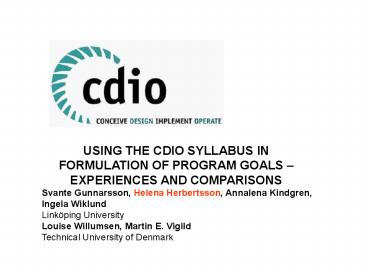USING THE CDIO SYLLABUS IN FORMULATION OF PROGRAM GOALS - PowerPoint PPT Presentation
Title:
USING THE CDIO SYLLABUS IN FORMULATION OF PROGRAM GOALS
Description:
Title: LIPS model at LiU Author: Tomas Svensson Last modified by: MEV Created Date: 2/4/2003 9:48:22 PM Document presentation format: On-screen Show – PowerPoint PPT presentation
Number of Views:49
Avg rating:3.0/5.0
Title: USING THE CDIO SYLLABUS IN FORMULATION OF PROGRAM GOALS
1
USING THE CDIO SYLLABUS IN FORMULATION OF PROGRAM
GOALS EXPERIENCES AND COMPARISONS Svante
Gunnarsson, Helena Herbertsson, Annalena
Kindgren, Ingela Wiklund Linköping
University Louise Willumsen, Martin E.
Vigild Technical University of Denmark
2
Main messages
- The CDIO Syllabus and related tools are very
useful and valuable in formulation of program
goals. - Local adaptation of the CDIO Syllabus can be
needed. - The development process is closely related to the
internal organization of the university. - Support from management, faculty members, and
students is essential. - The development processes within Linköping
University (LiU) and Technical University of
Denmark (DTU) show many similarities, but also
interesting differences.
3
The CDIO Syllabus
- The CDIO Syllabus is the foundation for the
formulation of program goals and learning
outcomes - Technical knowledge and reasoning
- Personal and professional skills and attributes
- Interpersonal skills Teamwork and communication
- Conceiving, designing, implementing and operating
systems in the enterprise and societal context
4
LiU-adaptation of the CDIO Syllabus
- Stronger emphasis in Section 4.1 on sustainable
development. - Extension of the scope in Section 4 of the
enterprise context. - Alternative version of Section 4 for programs in
natural sciences.
5
DTU-adaptation of the CDIO Syllabus
- Simplified, compared to the original document.
The most detailed level of the skills were left
out. - Considers only Sections 2 4 (first round
implementation) - Adapted to six B Eng programs
- civil, architectural, IT, electrical, chemical
and mechanical engineering.
6
Additional tools
- Motivation
- Tools to describe the structure and level of
proficiency. - Approaches
- LiU ITU-matrices
- DTU Skill progression matrices
7
ITU-matrix
- ITU-matrices can be formed for courses as well as
for programs - A way to describe which parts of the CDIO
Syllabus that are covered in a course - An approach to characterize the progression
between courses
8
ITU-matrix (cont)
- I Introduce. New topics are presented in the
course. Not examined. - T Teach. Topics subject to specified learning
outcomes. Basis for examination. - U Utilize. Knowledge and skills from previous
courses. Indirectly part of the examination.
9
Course level ITU-matrix
10
Program level ITU-matrix
11
Skill progression matrix
- Main idea Describe the progression using Blooms
taxonomy
Bloom level 0 1 2 3 4 5
Color
Know Understand Apply Analyse Synthesise
12
Skill progression matrix part I
DTU Syllabus 2.1 2.2 2.3 2.4 2.5 3.1 3.2 3.3 4.1 4.2 4.3 4.4 4.5 4.6
Calculus and algebra 1 1 1 1 1
Structural elements and their function (1) 2 2 1 1/2 1 1
Urban Planning and Design 2 2 2 1 1/2 1 1
CAD, sketching and 3D-modelling 1 1
Theory and Practice of Architectural Engineering 2 2 2 2 1 1/2 1
Material science 2 1/2 1 1
CDIO project 3 2 2 1
Calculus and algebra 2 2 2 2
CAD, sketching and 3D-modelling 2 2
Theory and Practice of Architectural Engineering 3 2 2 3 2 2
Structural elements and their function (2) 3 3 2 3 2 2 1 2
House Building and Building Design 2/3 3 2 2 2 2/3 2 2 1 1 2 1
CDIO project 3 2 2 2
13
Skill progression matrix part II
Physics 3 3 3
Structural design and models (1) 4 3 2 3 2 3
Urban context large structures 4 3 4 3/4 3 3
Planning and Visualization 3 1
Architectural engineering backgr. 4 4 3 4 3 3
Basic building design 4 3 3 3
Geometry 4 4 4
CDIO project 4 3 2 3/4 2 3
Systematical planning with CAD-system and Visualization 4 4
Background for architectural engineering 3 4 3 4 4 4
Structural Design and Models (2) 4 4 4 4 2 4
A concert hall 4 3 4 4 4 4 1
Basic building design indoor environment, services and energy 4 3 3 4 4 4 4 1
CDIO project 4 3 3 4 2 4
14
Observations and comparison
- Alternative approaches for describing progression
Bloom levels vs. ITU - A way to characterize complexity of engineering
tasks would be useful - Inclusion or exclusion of Section 1 of the CDIO
Syllabus in the work - Different approaches for 3 years B Eng programs
and 5 years M Sc programs
15
Conclusions
- The CDIO Syllabus and related tools are very
useful when formulating program goals and
learning outcomes. - The documents and tools enable a systematic way
to connect program and course goals. - Future activities involves ways to include the
various types of assessments. - Large scale use and maintenance require a well
developed organization.































